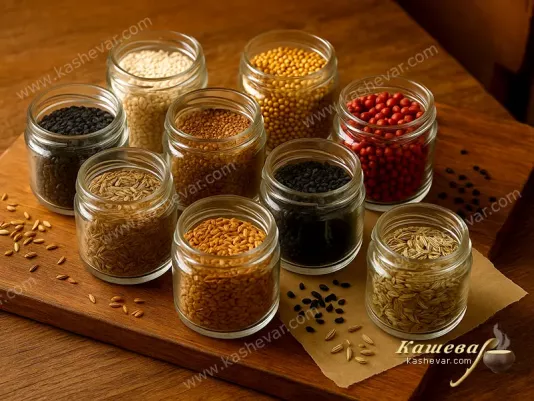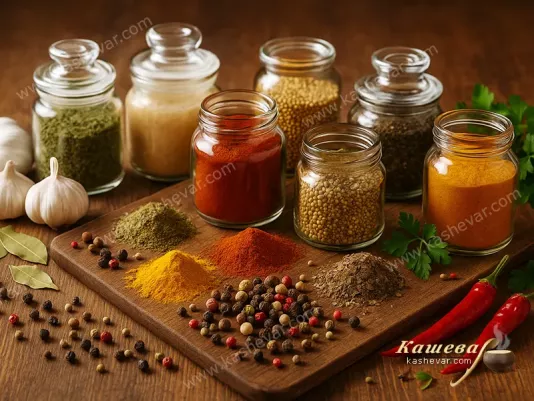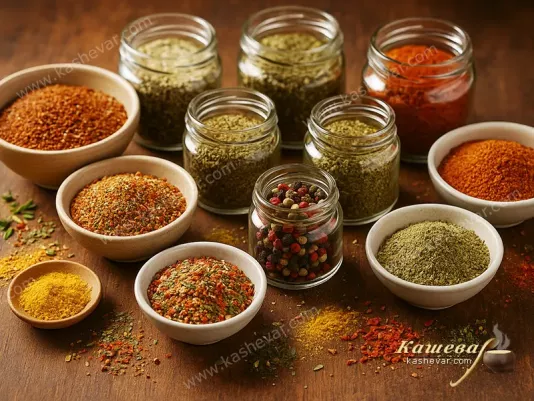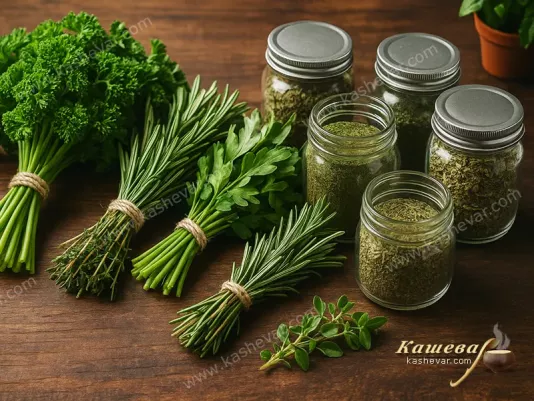Spices, Herbs and Blends
Spices, herbs and blends I consider an essential part of my kitchen, because they create that unique flavor that is remembered for a long time. When I use spices, I add depth and brightness to dishes, as pepper, coriander or turmeric can completely change the mood of even a simple recipe. Herbs for me are a note of freshness and a sense of lightness – I always use dill, parsley or basil to give dishes naturalness and harmony. And spice blends such as garam masala, khmeli-suneli or Herbes de Provence allow me to quickly achieve the perfect balance, combining the traditions of different world cuisines. For me, it is important that all these ingredients not only enrich the taste but also bring health benefits, as they contain natural substances that support well-being. That’s why I always fill my kitchen with this variety – it makes cooking exciting and inspires new culinary discoveries.
Different Types of Spices, Herbs and Blends
Spices in Cooking and Their Role in Flavor
Over the years of cooking, I’ve realized that spices are truly the soul of a dish. They can make a simple meal refined and turn an ordinary soup into an exquisite delicacy. For example, I use black pepper every day because it enhances the taste of almost any food. Turmeric for me is color and warmth – I add it to rice, soups or sauces to get not only a bright shade but also health benefits. Cinnamon and cloves give desserts coziness and sweet spiciness, while cardamom adds sophistication to pastries and drinks. I always see that spices shape the character of a cuisine. For example, cumin and coriander create an Eastern accent, while nutmeg adds softness to sauces or vegetable purées. When I use spices, I think not only about taste but also about balance. I never overspice dishes, because I know that even a pinch can change everything. My rule is to add less rather than more, and then gradually adjust the flavor. For me, spices are also a way to make food healthier. Many of them have antioxidant or anti-inflammatory properties, so I confidently use them every day. For example, ginger aids digestion, and cinnamon helps maintain stable blood sugar levels. For me, cooking with spices is harmony between flavor and health, and thanks to them I can create dishes that bring both pleasure and benefits.
Herbs and Their Role in the Daily Diet
I always have a special love for herbs because they add freshness, lightness and natural aroma to dishes. When I use parsley or dill, even the simplest soup or salad gains a completely different character. Fresh herbs for me are a way to emphasize the naturalness of products, making the taste clean and harmonious. In the summer, I often cook with lots of greens because they make the menu more varied and healthy. I use dried herbs in the colder months when fresh ones are not always available, and thanks to them I can preserve bright flavors even in winter. I’ve learned to appreciate the individuality of each herb. For example, rosemary adds depth to meat dishes, while thyme brings warmth and harmony to stewed vegetables. Basil creates a Mediterranean atmosphere in sauces and pasta, while mint brings lightness and coolness to desserts and drinks. Oregano I use for pizza and casseroles, and bay leaf for soups and stews – these herbs are indispensable for me. In my kitchen, herbs are also a source of health. They are rich in vitamins and trace elements, aid digestion and strengthen immunity. I’m sure that their regular use makes food not only tastier but also healthier. My experience shows that combining fresh and dried herbs allows me to create a rich bouquet of flavors and aromas. That’s why I always keep a set of my favorite herbs at home and use them daily, turning ordinary food into true culinary pleasure.
Spice Blends and Their Convenience in Cooking
From my experience, spice blends greatly simplify the cooking process and help quickly achieve harmonious flavors. When I cook meat or vegetables, I often use ready-made combinations such as garam masala, khmeli-suneli or Herbes de Provence. They allow me to effortlessly add depth and aroma to a dish, as if I had carefully selected the ingredients by hand. For me, this is convenient in everyday life when time is short but I want a rich flavor. I’ve noticed that spice blends expand culinary possibilities. For example, curry helps create bright Asian accents even in simple dishes, while shichimi togarashi adds spiciness to noodles or rice. For soups and sauces I use kharcho-suneli or utskho-suneli, as they give dishes a special Caucasian touch. Ras el hanout was a discovery for me – it creates the atmosphere of Eastern cuisine thanks to its complex and multi-layered aroma. Another advantage of blends is their versatility. I use them both for festive and everyday meals. They help reduce the amount of salt, since they themselves add richness, making food healthier. My experience shows that it’s worth having several different blends for different occasions: spicy ones for experiments, classic ones for daily recipes, and gentle ones for light vegetable or fish dishes. Thanks to blends, I’m always sure I can quickly prepare tasty and balanced food that will please the whole family.
Combining Spices, Herbs and Blends in Dishes
Over the years I’ve realized that real culinary magic happens when spices, herbs and blends are combined. For example, I often use black pepper together with bay leaf and parsley in soups – such a set creates a classic base that always works. For meat, I like to combine rosemary and garlic with spices like paprika or cumin, and sometimes I add blends like khmeli-suneli to get a deep and rich aroma. I see that herbs make the flavor softer and more natural, spices add expressiveness, and blends help quickly create a ready-made ensemble. I enjoy experimenting and finding my own favorite combinations. For vegetables, I often use basil and oregano, and on top add a little dried Herbes de Provence to highlight freshness. In marinades, I combine turmeric, ginger and mint – this set works perfectly for chicken or fish. And for sauces I mix cilantro with coriander and a small amount of garam masala to give the dish an Eastern note. The main rule I always follow is not to overload the dish. I add spices gradually and always taste the food to find the balance. When I teach beginners to cook, I always advise them to start with simple combinations and then gradually complicate them. That’s exactly how I learned myself: from classic combinations to complex and multi-layered ones. Now I confidently combine spices, herbs and blends, creating unique flavors that delight both me and my family.
Storage and Practical Tips for Use
Over the years I’ve realized that proper storage of spices, herbs and blends directly affects the quality of dishes. I always keep them in glass jars with tight lids, away from sunlight and heat, since this way they keep their aroma longer. I store fresh herbs in the refrigerator wrapped in a damp towel, or place them in a jar of water like a bouquet. I use dried herbs for no more than a year, as I know that over time they lose their strength. I always grind whole spices right before use – this way the taste is brighter and fresher. In use I follow a simple rule: fresh herbs I add at the end of cooking so they don’t lose aroma, while dried spices and blends I put in at the beginning or middle so they fully open up in the dish. For example, I add bay leaf straight into the broth, and parsley right before serving. Blends for me are a convenient way to quickly give a dish character, especially when there’s little time. I always have several ready-made sets that save me on busy weekdays. My main advice is not to be afraid of experiments. I try new combinations, create my own blends and always pay attention to product quality. Even a small amount of spice or herb can completely change the taste of a dish. For me, it’s important that spices and herbs are always at hand: they make food not only tastier but also healthier, bring joy and inspiration. Thanks to them, my kitchen is always filled with aromas, and every dish has its own character.



